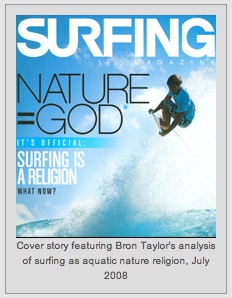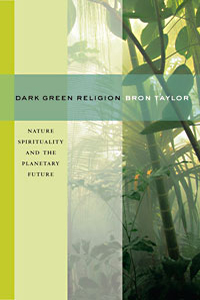DARK GREEN RELIGION:
NATURE SPIRITUALITY AND
THE PLANETARY FUTURE
Chapter 5. Surfing Spirituality
(Listed In Order of Page and Paragraph Number In Dark Green Religion)
In Dark Green Religion I mentioned how Drift and Surfing magazines drew on my analysis of surfing as a form of aquatic nature religion. In August 2007, based on a draft of a paper I put online for comment, Howard Stanwick featured my analysis of Surfing as Aquatic Nature Religion. As I wrote in Dark Green Religion, his rationale for this feature further exemplifies dark green spirituality (see his afterword on p. 148 of the magazine). A few years later, Swanwick turned this feature into a slideshow, along with other featured articles, some of which also exemplify surfing spirituality.

After my article on Surfing Spirituality was published in the Journal of the American Academy of Religion (December 2007), Surfing Magazine also featured the idea in its July 2008 issue, the cover of which is shown above. It repeated surfing legend Tom Blake's words, which I had quoted in my article, Nature = God. The article included interviews with many surfers who understand their practice as spiritual.
Jim Rawlinson was surfing in Hawai'i when suddenly a Tiger Shark chomped down on the back of his board, pulling it underwater, lifting the front of his board into the air, causing him to slip down the board right onto the back of the shark. At this point, Rawlinson reported, "I was about two feet back from his nose. I think he was about two feet wide from how my legs were spread across him, like a horse. You know, I couldn’t see his eyes because I was on top, but I felt like there was some connection here and it was real peaceful." He added later, in a way reminiscent of others described in Dark Green Religion who have encountered great predators, that as a result of this experience, he felt "humbled and blessed."
Additional resources follow that illustrate the ways in which some surfers understand their practice as a form of nature religion.Alice DiMicelle provides a great example of aquatic nature spirituality in a music video featuring kayak surfing.>
The Evolution of Surfing by Ross Cummings, which I discovered by searching for “surfing spirituality” on youtube, is one video example of those who consider surfing a form of nature spirituality that promotes environmental concern.
Surfrider Foundation
Groundswell Society
Surfer's Environmental Alliance
Save our Seas
Surfing Heritage Foundation, 'Building a Community of people who share a common passion for the Spirit, Soul and Culture of Surfing." The foundation is engaged in recording oral histories and otherwise archiving the historical development of surfing culture, globally, and has plans for a major museum to house its growing collection. Photographs will soon be posted from my August 2010 visit.
Surfers Journal. Steve Perzman, the founding publisher of Surfers Journal, in reflecting on its history, wrote that it was developed with "experienced, intelligent surfers" in mind. He then added, "despite all the philosophic and poetic waxing about man and wave, the connection to nature, and the quasi-religious experience of the ride," those producing it don't take themselves too seriously. I had the opportunity to speak with Perzman in August 2010 in San Clemente, California, which reinforced my impression that he and the journal he founded is a good example of dark green spirituality.
Wave Dancers Surf Tribe expresses many themes common to dark green religion, including a critique of "totalitarian agriculture" (drawing on Daniel Quinn), a stress on the need to evolve culturally and spirituality, a vision "to live the simplest life that allows for greatest happiness. We will daily be focused on food, shelter, clothing, and surf. As a nomadic tribe of surfers, we shall embrace all that is aquatic and support one another in our daily lives. Living on sailboats will be our connection with the ocean, becoming expert watermen in wind, waves, and tides. . . . We will strive at all times to have a positive impact on the environment and become stewards of the ocean and lands that sustain us. We only take what we need on a daily basis and do not waste any of our natural resources. We chose to be our own individual messiah. We wish to live in peace and once again embrace all of nature that exists in and around us." As noted in Dark Green Religion, this site provides another example of surfers expressing appreciation for Timothy Leary's positive evaluation of surfing spirituality.
Par 3., on surfboard making as nature spirituality:
The website of the Hawaiian Boarding Company demonstrates that surfboard making, understood as a spiritual practice in which the life force in the tree used for the board must be respected, has survived into the 21st Century. The site explained, “Pohaku [the native craftsman] must choose the right log or wood for the surf board he is going to carve. Once the right wood is found, there is the offering of the ho'okupu (ritual sacrifice) to the gods and ancestors to ask permission to take the wood. This is our native way of assuring the gods that the life of the wood will continue, just in another form. This protocol is the honoring of the gods and our ancestors for the knowledge of the old ways.
Once the wood has been blessed, he then rough cuts the log into the general length and width of the surfboard type he is building.
The next step is the offering of the ‘awa (kava) to invoke the awakening of the spirit that resides in the wood, in this way Pohaku connects with that spirit and sees the image that will be created from the wood and the name that will be given to that work of art. He is then able to measure by eye and outline the surfboard that lies within the wood.
Now the labor-intensive stage of carving the outline of the board begins. It is vital for Pohaku to follow the lines of the shape he has seen, while maintaining the integrity of the natural flow of the wood.” The more mundane aspects of the building process was then described in detail. The narrative continued that, after the board is finished, “the final ho'okupu offering is made to recognize the new life of the wood, assuring the gods that the original life of the wood is continuing in this new form.” See http://www.hawaiibc.com/surf.htm (quotes found there February 2006).There is more than meets the eye to the deep water swells as they march majestically across the sea, to the silent drums of the atom. Dedicated sailors of all times knew this. So do surf riders who have spent years of their lives viewing these waves at close range, as the locked in power is released upon the reefs and shores in a symphony of sound, and shapes of strange dimensions.
All of this the surf rider has going for him, and he experiences a peculiar joy and inner satisfaction in putting this force to work under a board. This may be because that force is a spiritual, a divine force that has been in production by nature or God for a long time. Why say nature or God? Just this: over the years, the close association with waves of all kinds, coupled with a religious background, has convinced this old surf rider that nature is synonymous with God. So the word nature, for all practical purposes may be usefully used as an alternate to the word God, to better understand life, living, and the ocean wave, as part of the almighty and thus give due credit and respect for its mysterious hidden energy. The same formula applies to all things; each has a bit of the divine power to sustain it; be it an atom, a wave or man.
[Gary Lynch and Malcolm Gault-Williams, Tom Blake: The Uncommon Journey of a Pioneer Waterman (Corona Del Mar, CA: Croul Family Foundation, 2001), 205-06, Blake's emphasis.]Par. 3, Warshaw on surf movies, additional quote:
Context is everything with surf movies. Watching a surf movie on TV today is like seeing a photo of Woodstock on a postcard. The genuine surf movie experience was (and to some degree still is) dependent on place and locale, requiring not only a big screen but crowds and anticipation and noise and at least a dozen quick-witted hecklers, plus a half-pint of Schnapps getting handed your way, and a nice big fatty in your shirt pocket. A passing and slightly manic togetherness was the surf film’s strangest byproduct. [Warshaw, Surf Movie, 7.]
Religion scholar Jonathan Z. Smith once said “Ritual is not an expression of or a response to “the Sacred”; rather, something or someone is made sacred by ritual” (Smith 1987: 105). Perhaps the creation and watching of surf movies, especially when done collaboratively, contributed to the understanding of the practice as religious.
Par. 1, Other surfing films that illustrate the ethos of the era include The Cosmic Children (1970) and Nirvanic Symphony(1972). [Warshaw, Surf Movie, 72, 82.]
Par. 2, surfing magazines’ distribution: The U.S.-based Surfer’s Journal had a circulation of 30,000 in 2003, the United Kingdom based Surfer’s Path had 28,000 in circulation in the UK and exported another 20,000 to the States and other countries. According to Warshaw, who documented nearly 400 surfing magazines globally, the oldest and leading on isSurfer (originally The Surfer), which began publication in 1960, had a monthly circulation of 118,000 in 2002, while the more youth-focused Surfing magazine (originally International Surfing), circulated 120,000 in the same year [Warshaw, The Encyclopedia of Surfing, 754-57, 602-610.]Par. 1, Drew Kampion, additional quote:
Par. 1, on the peace some find only in the ocean:
The film Five Summer Stories (1972), which in 1987 was selected by Surfer magazine as one of the three best surf movies of all time (The Endless Summer topped the list), provides a cinematic example. [Warshaw, The Encyclopedia of Surfing, 203.] It began with a stunning sequence in which the camera is enveloped in rolling surf, and an evolutionary cosmogony is invoked in which the creation is depicted as beginning in the sea. The narrator then suggests that through surfing people can “escape the confusion onshore” (presumably including the antipathy that characterizes human societies) and thereby find “peace of mind.” See also the video resources.
Drawing on Australian survey research Peter Bentley and Philip J. Hughes, Australian Land the Christian Faith: Facts and Figures (Melbourne, Australia: Christian Research Association, 1998), Nancy Victorin-Vangerud demonstrated the deep connection to the sea and corresponding and sense of peace the majority of Australians derive from it; see Nancy M. Victorin-Vangerud, "The Sacred Edge: Women, Sea and Spirit," Sea Changes: the Journal of Women Scholars of Religion and Theology 1 (2001). I am grateful to Sylvie Shaw for pointing me to this work.Par. 1, a spirituality of connection and belonging to nature, similar to the one expressed by Marilyn Edwards, is common in dark green religion. A Unitarian seminarian, for example, described his own sense of belonging to nature in a 1994 sermon entitled the “Tao of Surfing”:
Par. 3, Bill Devall, with the Philosopher George Sessions, produced the most influential early book promoting the deep ecology movement; see Bill Devall and George Sessions, Deep Ecology: Living as if Nature Mattered (Salt Lake City, UT: Peregrine Smith, 1985). Devall, who died 26 June 2009, was a sociology professor at California State University, Humboldt, in Northern California. He was also periodically involved with radical environmentalist campaigns there and worked with Earth First!
Par 3, note 65, Joseph Price on Mircea Eliade:
Par. 2, more from Glenn Hening, on the experience “shooting the tube”:
Par. 1, more examples of efforts to intgrate Kahanamoku’s aloha spirit and respect for indigenous cultures in surfing cultures:
In addition to trying to hold positive, feel-good surfing events, the Groundswell Society borrowed an idea from the Australian Shaun Tomson, creating a “Surfing Tribes Youth Program.” It seeks to teach children “what it means to have your life centered around waves and beaches” and provide “a special opportunity for your daughters and sons to have fun while learning about our true tribal ancestors in California, surfing cultures around the world, the special place of children in our surfing community, and our responsibilities to care for each other and our environment” (Groundswell Society Annual Publication 2002, version 2.0, 7).]
Par. 2, on fears of surfing fundamentalism:Matt Walker, for example, has seen in surfing subcultures, and himself, “the same fundamentalism, fear and self-righteousness that turned me off to organized religion in the first place.” In this he worried about the “proof that any source of unbridled joy can easily turn into seething hatred. Even inside my own heart.” [Walker, "Science of Stoke," 130.] I have heard similar worries expressed by radical environmentalists about their spirituality. Those with such worries, however, are unlikely to become fundamentalist extremists, of course, and are more likely to resist such developments within their subcultures.


